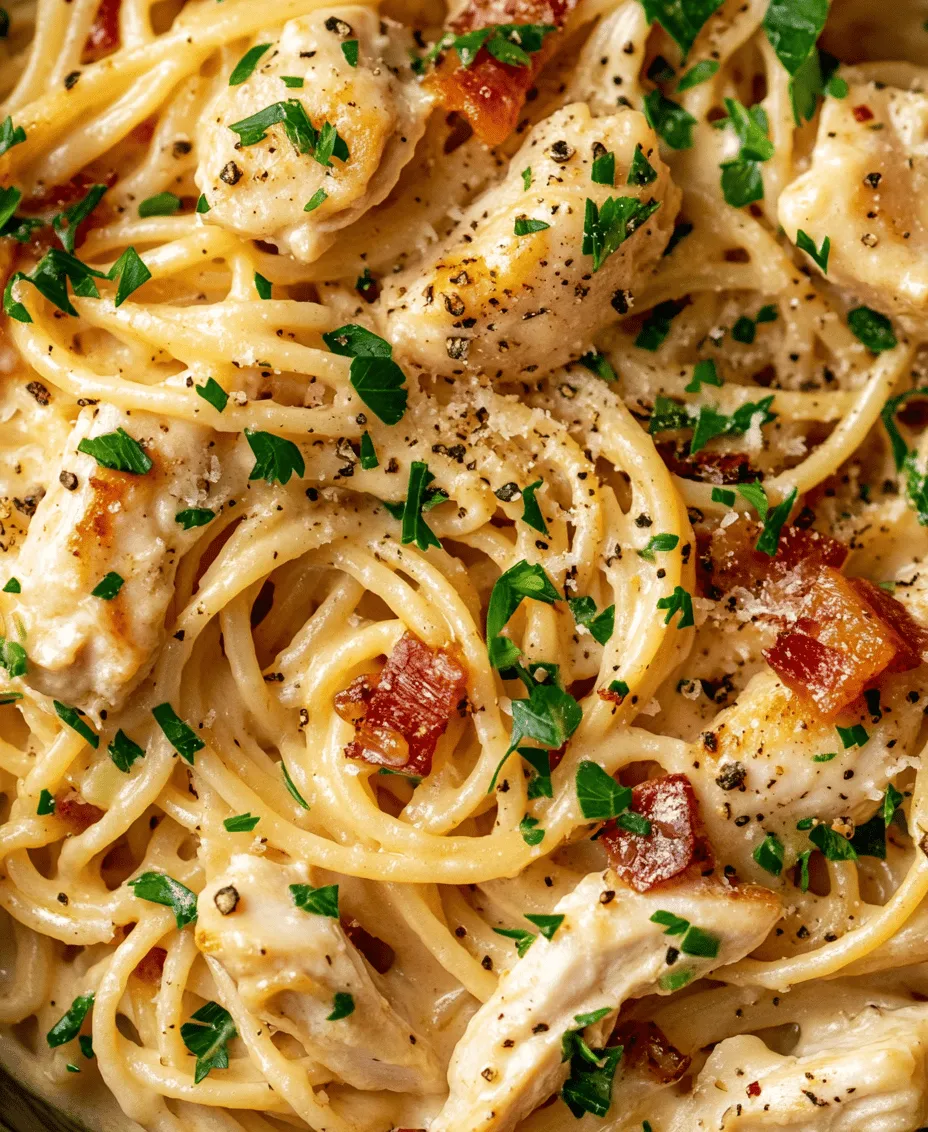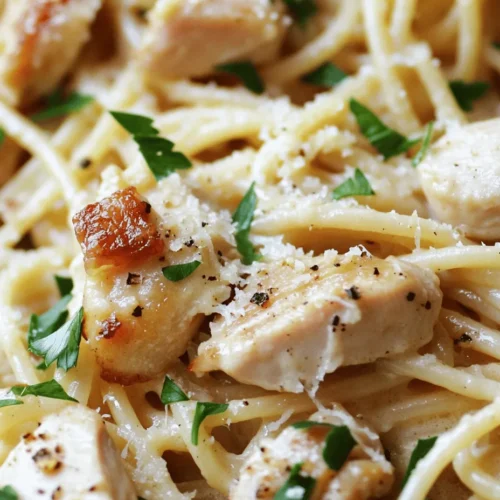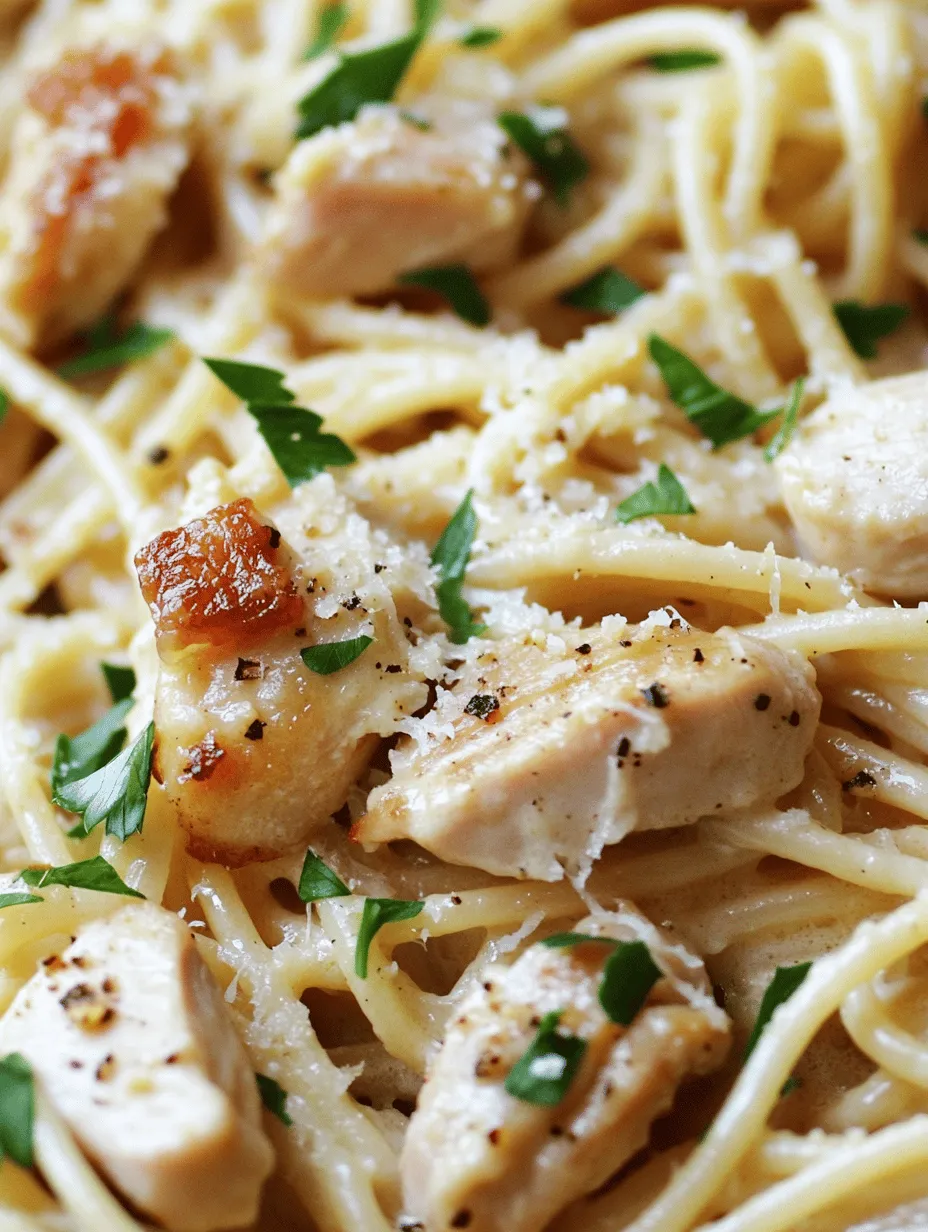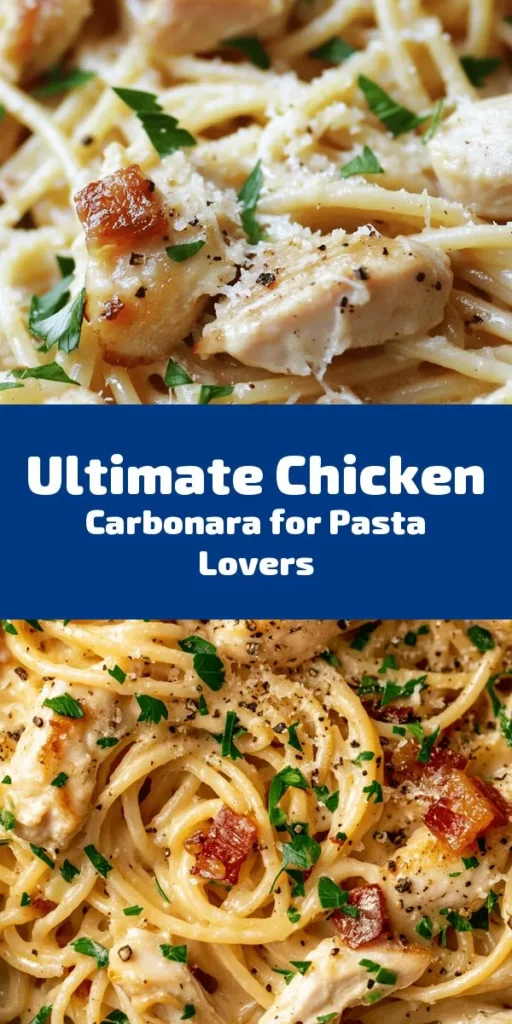Introduction
Chicken Carbonara is a beloved Italian dish that has captured the hearts and palates of food enthusiasts around the world. Known for its rich, creamy sauce and hearty ingredients, this classic dish is not just a meal but a celebration of flavors and culinary tradition. While traditional Carbonara typically features guanciale (cured pork cheek), the addition of chicken provides a delightful twist that elevates the dish to new heights.
One of the keys to mastering Chicken Carbonara lies in the quality of the ingredients. Using fresh, high-quality items will enhance the dish’s overall flavor and authenticity. The promise of a creamy, flavorful, and satisfying meal is not just an invitation; it’s a guarantee when you follow the right steps. This recipe will guide you through creating a Chicken Carbonara that is not only easy to prepare but also delivers a restaurant-quality experience right in your kitchen.
Understanding Carbonara
The origins of Carbonara are steeped in culinary folklore, making it as fascinating as it is delicious. While its exact beginnings are debated, many believe that Carbonara emerged in the mid-20th century in Rome, inspired by the traditional dishes of the Italian countryside. The name itself is thought to derive from ‘carbonaro,’ meaning ‘coal worker’ in Italian, suggesting that it was a meal favored by those who toiled in the coal mines.
Traditional Carbonara is composed of a handful of simple yet flavorful ingredients: pasta, guanciale (or pancetta), eggs, Pecorino Romano cheese, and black pepper. These elements come together to create a sauce that clings beautifully to the pasta, rich in flavor without being overwhelming.
As you explore Carbonara, you’ll find that variations exist across different regions of Italy. Some regions may incorporate cream or additional vegetables, while others remain steadfast to the original recipe. Regardless of the style, the essence of Carbonara remains intact: a dish that is both hearty and comforting.
Central to the dish’s signature creamy sauce are the eggs and cheese. When combined, the heat from the freshly cooked pasta gently cooks the eggs, creating a luscious, velvety texture that is the hallmark of a great Carbonara. This unique method of sauce-making is what sets Carbonara apart from other pasta dishes, allowing for a beautiful blend of flavors that is both satisfying and indulgent.
Ingredients Breakdown
Spaghetti or Fettuccine: Choosing the Right Pasta for Texture
When it comes to Carbonara, the type of pasta you choose can significantly influence the dish’s final flavor and texture. Spaghetti is the most common choice, with its long, thin strands perfectly capturing the creamy sauce. However, fettuccine is another excellent option, offering a broader surface area that allows the sauce to cling well. Ultimately, the choice between spaghetti and fettuccine comes down to personal preference, but both will yield delicious results.
Chicken Breasts: Importance of Using Fresh Chicken for Tenderness
Fresh chicken breasts are a crucial component of this Chicken Carbonara recipe. Not only do they add a lean protein element, but they also contribute to the dish’s overall tenderness and flavor. Opting for high-quality, fresh chicken will enhance your Carbonara, ensuring that every bite is juicy and satisfying.
Before cooking, consider marinating the chicken in a bit of olive oil, salt, and pepper. This simple step will infuse the chicken with flavor and moisture, resulting in a more flavorful final dish.
Pancetta vs. Bacon: Flavor Profiles and Cooking Considerations
While traditional Carbonara utilizes guanciale, many home cooks opt for pancetta or bacon due to their availability. Pancetta, an Italian cured meat, offers a rich, savory flavor that enhances the dish. It is slightly less smoky than bacon, making it a fantastic choice for Carbonara, as it allows the other flavors to shine through.
If you prefer bacon, choose a high-quality option with minimal additives for the best flavor. Keep in mind that bacon tends to be smokier, which can alter the overall taste of the dish. Regardless of which option you choose, cooking the meat until it is crisp will add a delightful texture contrast to the creamy sauce.
Eggs and Parmesan: How These Ingredients Create the Creamy Sauce
At the heart of Carbonara’s allure lies the combination of eggs and cheese, specifically Parmigiano-Reggiano or Pecorino Romano. These ingredients work in harmony to create the dish’s signature creamy sauce. When the eggs are whisked together with the grated cheese, they form a rich, custard-like mixture.
As you mix this combination with the hot pasta, the residual heat gently cooks the eggs, resulting in a silky sauce that envelops each strand. This technique is what sets Carbonara apart from other pasta dishes and is essential for achieving that authentic texture.
Garlic and Olive Oil: Enhancing Overall Flavor and Aroma
Garlic and olive oil serve as key flavor enhancers in Chicken Carbonara. The garlic infuses the dish with its aromatic essence, while olive oil adds a rich, fruity note that complements the other ingredients beautifully. When sautéed together, they create a fragrant base that elevates the entire dish.
Using high-quality extra virgin olive oil will enhance the flavor profile of your Carbonara. A gentle sauté of minced garlic in olive oil before adding the chicken will ensure that the flavors meld and create a delicious foundation for the dish.
Fresh Parsley: Adding Freshness and Visual Appeal
Lastly, fresh parsley plays a vital role in Chicken Carbonara. Not only does it add a pop of color, but it also contributes a fresh, herbaceous note that balances the richness of the sauce. Chopping some fresh parsley and sprinkling it over the finished dish will not only enhance the visual appeal but also provide a refreshing contrast to the creamy elements.
Step-by-Step Instructions
Now that you have a thorough understanding of the ingredients, it’s time to dive into the preparation of your Best-Ever Chicken Carbonara. This step-by-step guide will ensure that you achieve the perfect balance of flavors and textures for a truly satisfying meal.
Cooking the Pasta: Tips for Perfect Al Dente Texture
1. Boil Water: Begin by bringing a large pot of salted water to a rolling boil. The salt is crucial, as it seasons the pasta while cooking. Use about 1 tablespoon of salt for every 4 quarts of water.
2. Add Pasta: Once the water is boiling, add your chosen pasta—spaghetti or fettuccine. Stir occasionally to prevent sticking.
3. Cook Until Al Dente: Follow the package instructions for cooking time, but start checking for doneness about a minute before the recommended time. The pasta should be cooked al dente, meaning it should have a slight firmness when bitten. This texture will stand up well when combined with the sauce.
4. Reserve Pasta Water: Before draining the pasta, reserve about 1 cup of the cooking water. This starchy water can be used later to adjust the sauce’s consistency.
5. Drain and Set Aside: Drain the pasta and set it aside, but do not rinse it, as the starch helps the sauce adhere to the noodles.
With the pasta cooked to perfection and the understanding of the ingredients firmly in place, you’re well on your way to preparing a Chicken Carbonara that will impress your family and friends. Stay tuned for the next steps, where we will cover the cooking process for the chicken and the assembly of this delightful dish.

Cooking the Chicken: Ensuring It’s Tender and Well-Seasoned
To start making the best-ever Chicken Carbonara, the first step is cooking the chicken to perfection. For this recipe, boneless, skinless chicken breasts work best due to their mild flavor and quick cooking time. Begin by seasoning the chicken breasts generously with salt and freshly cracked black pepper. This simple step is crucial as it enhances the overall flavor of the dish.
Heat a large skillet over medium-high heat and add a tablespoon of olive oil. Once the oil is shimmering, carefully place the chicken breasts in the pan. Avoid overcrowding the skillet, as this can lead to steaming rather than searing. Cook the chicken for about 6-7 minutes on one side without moving it; this allows for a beautiful golden crust to form. Flip the chicken and reduce the heat slightly, cooking for an additional 5-6 minutes, or until the internal temperature reaches 165°F (75°C).
Once cooked, remove the chicken from the skillet and let it rest for a few minutes. This resting period allows the juices to redistribute, resulting in tender, juicy chicken. After resting, slice the chicken into bite-sized pieces or strips, ready to be incorporated into the carbonara.
Preparing the Pancetta: Achieving the Ideal Crispiness
Next, let’s prepare the pancetta, which adds a savory richness to the dish. Pancetta can be found at most grocery stores, usually sold in thin slices or cubed. For this recipe, aim for about 4 ounces (or 115 grams) of pancetta.
Place a separate skillet over medium heat and add the pancetta without any added oil; it will render its own fat. Cook the pancetta for about 5-7 minutes, stirring occasionally, until it becomes crispy and golden brown. This step is crucial; the rendered fat will infuse the sauce with flavor, while the crispy bits will add texture to the dish.
Once the pancetta is cooked, use a slotted spoon to transfer it to a plate lined with paper towels to drain excess fat. Leave the rendered fat in the pan; it will be used in the next steps of the recipe.
Whisking the Egg Mixture: Importance of Temperature Control
As the pancetta cooks, you can prepare the egg mixture that will create the creamy sauce for the carbonara. In a medium bowl, combine 2 large eggs and 1 large egg yolk with 1 cup of freshly grated Pecorino Romano cheese. Whisk the mixture vigorously until it’s well blended and creamy.
One key to achieving a smooth sauce without scrambling the eggs is temperature control. To prevent the eggs from cooking too quickly when combined with the hot pasta, it’s essential to temper the egg mixture. To do this, gradually add a few tablespoons of the reserved pasta cooking water (which you should have saved before draining the pasta) into the egg mixture while whisking continuously. This technique helps to gently raise the temperature of the eggs, ensuring they remain smooth and creamy when mixed with the pasta.
Combining All Elements: Techniques for a Smooth and Creamy Sauce
Once the spaghetti is cooked al dente, drain it but reserve about 1-2 cups of the pasta water. This starchy water is essential for achieving the desired consistency in your sauce.
In the skillet with the pancetta fat, add the drained pasta and the sliced chicken. Toss everything together over low heat to coat the spaghetti in the flavorful fat. This step also warms up the chicken, ensuring it’s served hot.
Next, remove the skillet from heat to avoid scrambling the eggs. Slowly pour the egg mixture over the pasta, stirring continuously as you do so. The goal is to create an emulsion: the heat from the pasta will gently cook the eggs, turning them into a creamy sauce. If the sauce appears too thick, gradually add reserved pasta water until you reach your desired consistency. The sauce should cling to the pasta without being overly runny, creating that classic carbonara texture.
Final Presentation: Plating Suggestions for an Appealing Dish
Presentation is key when serving Chicken Carbonara. After combining all elements, transfer the pasta to a serving bowl or individual plates. For a touch of elegance, you can use a pair of tongs to twirl the pasta into a nest shape. Drizzle a little extra virgin olive oil over the top for added flavor and richness.
To elevate the dish further, garnish with additional grated Pecorino Romano cheese and freshly cracked black pepper. A sprinkle of chopped parsley adds a pop of color and freshness, balancing the richness of the carbonara. For an authentic Italian touch, consider serving the dish with a side of crusty garlic bread and a simple salad dressed with olive oil and balsamic vinegar.
Tips for Customization
Suggestions for Ingredient Substitutions
For those wanting to play with the ingredients, there are several ways to customize the Chicken Carbonara. If you’re looking to add more nutrition, consider incorporating vegetables such as peas, spinach, or roasted cherry tomatoes. These can be added to the pasta during the last few minutes of cooking or sautéed with the pancetta.
If you’re not a fan of pancetta, you can substitute it with bacon or even turkey bacon for a lighter option. Additionally, for a vegetarian twist, replace the chicken with grilled mushrooms or zucchini, and use a plant-based cheese alternative.
Adjusting Flavors
Flavor adjustment is also key to making this dish your own. If you prefer a spicier kick, add a pinch of red pepper flakes to the pancetta while it cooks. Alternatively, for a more aromatic dish, toss in some minced garlic with the pancetta or chicken.
Dietary Variations
For those with dietary restrictions, consider making a lighter version of Chicken Carbonara. You can replace traditional pasta with whole wheat or gluten-free pasta. For a lower-calorie option, use egg whites instead of whole eggs, and reduce the cheese quantity while adding more vegetables to maintain flavor.
Common Mistakes to Avoid
Overcooking the Pasta or Chicken
One of the most common mistakes when making Chicken Carbonara is overcooking the pasta or the chicken. Overcooked pasta becomes mushy, which detracts from the dish’s overall texture. To avoid this, always cook your pasta al dente, ensuring it retains a slight bite. For the chicken, use a meat thermometer to check for doneness, ensuring it reaches an internal temperature of 165°F (75°C).
Incorrect Egg Temperature
Another critical mistake is not controlling the temperature of the egg mixture. If the eggs are too cold when combined with the hot pasta, they may scramble instead of creating a creamy sauce. Always temper the eggs with reserved pasta water before adding them to the dish.
Skipping Reserved Pasta Water
Lastly, never skip reserving pasta water. This starchy liquid is essential for achieving the right consistency in your sauce. It helps to bind the sauce to the pasta and provides that silky texture characteristic of a proper carbonara.
Nutritional Information
Chicken Carbonara is a hearty dish, and understanding its nutritional profile can help you make informed decisions. On average, a serving (about 1 cup) of Chicken Carbonara contains approximately:
– Calories: 600-700
– Protein: 35-40 grams
– Carbohydrates: 65-70 grams
– Fats: 25-30 grams
Balancing the Meal
To create a balanced meal, consider serving Chicken Carbonara with a light side salad or roasted vegetables. A simple arugula salad with lemon vinaigrette can brighten the meal and provide a fresh contrast to the rich carbonara.
Conclusion
Chicken Carbonara is more than just a comforting pasta dish; it’s a versatile and satisfying meal that can be adapted to suit any occasion. Whether you’re enjoying a quiet dinner at home or impressing guests with a homemade Italian feast, this recipe is sure to delight.
Don’t hesitate to experiment with flavors and textures, making it your own. Homemade Italian cuisine is all about personal touch and creativity, so feel free to adjust the ingredients to suit your taste. Enjoy the process, and savor every bite of this delicious Chicken Carbonara, made with love in your kitchen.



